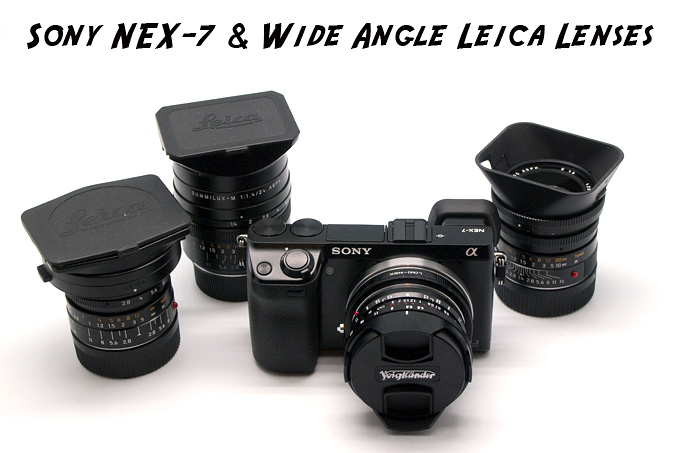
The Sony NEX-7 with wide angle Leica lenses – A quick test and GXR comparison!
UPDATED WITH A SONY NEX-5n vs NEX-7 COMPARISON for COLOR SHIFT
It’s FRIDAY and I am in the best mood ever today. Why? Well, It’s gonna be a killer Halloween weekend. I love Halloween, and this year I am going to a couple of parties and am planning on bringing my camera along with me. Which one? Probably the E-P3 and Panasonic 20 1.7 due to it’s fast AF. I will not be bringing the NEX-7 because A: It is not mine and B: I have to send it back on Monday to Sony. I have enjoyed my time with the camera and shot with it daily for the last 3 weeks or so and it seems my last ISO comparison between the 7 and 5n stirred up some controversy (and traffic..and some commenters that wouldn’t stop)! Bottom line is that I shot each camera in that test how they were meant to be shot. I was showing what you can expect from each camera when using it and letting the camera choose the exposure. It is what you will get in real life, not scientific testing. Besides, the NEX-7 was NOT underexposed. But anyway….enough of that. The bottom line is that the 5n is a little better at high ISO than the 7, but we all knew this already didn’t we? Besides, who here shoots at 3200 and up on a regular or non regular basis? Not many. I am sure other sites will be doing all of the scientific testing soon so for those who crave that…patience!
LensRentals.com Sponsored this test!
Thanks to LenRentals.com I was able to do some quick tests on the NEX-7 with some wide angle Leica lenses! – Visit LENRENTALS.COM as they rent more than just Leica. They rent Sony, Olympus, Leica, Canon and Nikon – bodies, lenses and accessories!
So seeing that I wear able to get a hold of some lenses for a couple of days today I wanted to post some QUICK shots I snapped with the NEX-7 and these wide angles. I only had these lenses for three days so did not get to shoot much with them at all. I have been extremely busy with this site, e-mail, and personal things as well so I was just able to get out yesterday to shoot and I also brought along the Ricoh GXR M mount module (which I also have to return on Monday to Ricoh..contrary to popular belief, I do not get to keep anything).
But again let me thank LenRentals.com as they were kind enough to send me these lenses at no charge so I could do this test and add to my NEX-7 review. Without their help I could not have done this. So thank you LENSRENTALS!
–
Onto the Images!
So the images you see below are all quick and dirty test shots out of the camera. They are not meant to be good photos, just test shots that should give you an idea on how these lenses can perform on the NEX-7. Let’s face it. There is no way I can shoot winning photos 7 days a week in Phx AZ 🙂
One thing to notice in some of the images below and that is that the Leica 21 Elmarit and the Voigtlander 15mm have the bad magenta color shifts on the NEX-7 with the magenta edges/corners. The GXR does NOT do this so this shows how Ricoh got it right when designing their dedicated module, as they should have. It is a dedicated one trick pony module designed to do one thing and one thing right, and they succeeded. The 15 may not be perfect on the GXR but it is miles better than it is on the NEX-7. UPDATE! Just tested the 15mm on the NEX-5n and it is perfect! No color shift. This is disappointing to me and now I am am going to have to slightly alter my “conclusion” in my NEX-7 review. You can see the samples below…
The NEX-7 was obviously NOT designed for Leica glass. You can see that using lenses 24 and wider can get you some nasty color shifts, just like the M9 used to do (and still does with the Voigtlander). But the GXR and 5n are clean. Why the 5n works well and not the 7 is beyond me.
One other thing I noticed is that the Sony can put out a very sharp image when using 35mm and longer Leica lenses. The GXR is a tad sharper though. The 35 Lux performed wonderfully on the NEX even with the CHEAP adapter I used today that was a bit loose and wobbly. I accidentally left my good one on the 5n at home but it still worked out even though I had a few out of focus shots from the NEX, and IMO, this is due to the wobbly adapter.
–
OK, NOW the images!
CLICK EACH IMAGE FOR LARGER 1800 PIXEL WIDE VERSION
The NEX-7 and 35 Summilux ASPH at 1.4 – This one was from RAW (Capture One)
–
Again, the 35 Summilux wide open at 1.4 – focus peaking made this easy along with the tilting LCD (From RAW)
The 21 Elmarit at 2.8 (From RAW)
The 24 Summilux on the NEX-7 (JPEG)
Next three shots…35 Lux once again at 1.4 – (JPEG) – Notice the 3D effect in the Life Cereal shot – The word Cinnamon sort of jumps out when you view the full size image.
[ad#Adsense Blog Sq Embed Image]
Some quick comparisons with the Ricoh GXR
These were all converted from RAW. The GXR has a totally different color signature than the NEX.
This 1st shot was with the Leica 35 Summilux at f/4 – click image to see 100% crop – SHARP!!! (from RAW)
Here is the same scene but shot with the Ricoh GXR and 21 Elmarit at f/4 (from RAW)
Sony NEX-7 with the 21 Elmarit at f/5.6
GXR with 21 Elmarit at f/5.6 (again, from RAW and letting each camera choose the exposure to see how each camera will expose the same scene)
Here is a shot from inside a restaurant/bar with the NEX-7 and 24 Summilux at 1.4 (click image for larger)
Now the GXR, same lens, same aperture – totally different color signature (click image for larger)
Magenta Color shifts – The NEX-7 has them – GXR does not! NEX-5n DOES NOT!
1st shot – NEX-7 with the Voigtlander 15 at 5.6. Out of camera JPEG. This is the color that came out of the camera. Not good.
Now the same lens, same aperture, same OOC JPEG but from the Ricoh GXR
and the NEX-7 with the 21 Elmarit, same scene – still there but not as bad – more evident due to the light sky
–
and the NEX-7 with the 24 Summilux – still some magenta color shift in the corners
AND ONE MORE COMPARISON BETWEEN THE 5n and 7
First the 5n with the Voigtlander 15 at f/8
and now the 7…disappointing .
–
Who Wins?
So there you go. Some quick shots to show how these wider angle lenses work on the NEX-7. You do get the magenta color shift with the 15, 21 and even slightly with the 24. The GXR does much better here and did not show any shifting with the 21 or 24. The 5n also does wonderfully with no color shift. Hmmmm.
As for shooting these bodies, I did in fact enjoy using the Sony NEX-7 more as I stated before due to its EVF, superb peaking, and body feel/grip, which is just about perfect for my hand. The GXR, in use, was a little awkward in comparison but if you never see the Sony EVF or Peaking I can see someone being thrilled with the GXR in use. But all of the control and ease of use in the world means JACK if the IQ doesn’t stack up. If you are looking for a back up to your M and have been considering the GXR or NEX-7 AND have wider Leica glass, then the GXR would be your best bet. It does indeed work best with Leica lenses in regards to color shifting, and color in general. At the same time, if you just want to shoot an occasional 35 or 50 Leica lens and want to take advantage of everything the NEX-7 has to offer, then the 7 could be your solution. Overall, it is a powerhouse.
Then again, there is the Sony NEX-5n which just may be the one to go for as it has great high ISO performance (best of the three) and has no color shifting issues. Decisions decisions…
If the NEX-7 had the microlenses like the 5n obviously does, then I would call it a slam sunk between the three cameras. One of the reasons I wanted an NEX-7 was to shoot Leica lenses and now it appears the NEX-5n and GXR do a better job in this area. Arg! You can pre-order the GXR M mount A12 Module HERE, or the NEX-5n HERE.
Anyway, here are a few shots with some Post Processing just for fun, something I did not do to the images in my NEX-7 review, which I just updated. PP can add some excitement to any image and the Sony files seem to very robust, especially since all of the images below were taken from the OOC JPEG and then enhanced.
Thanks for reading, coming soon my Ricoh GRD IV review and my Nikon V1 review. Coming down the road, a review of the Panasonic/Leica 25 1.4 Summilux for Micro 4/3 and yes, the Fuji X10.
Steve

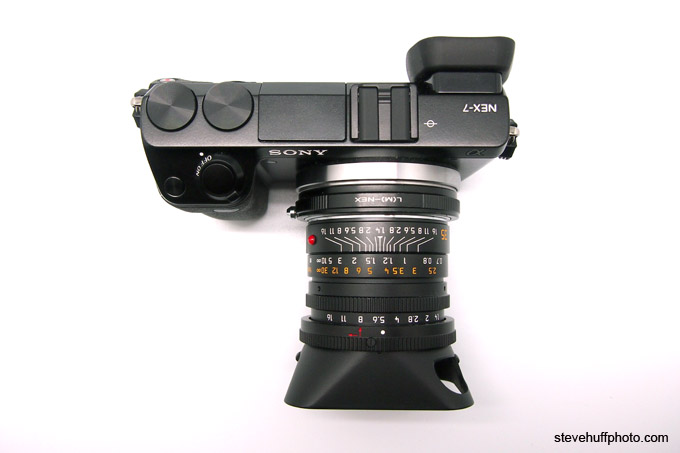

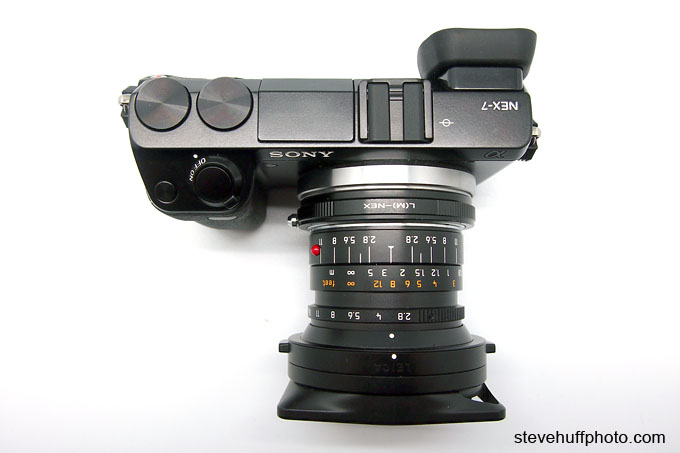
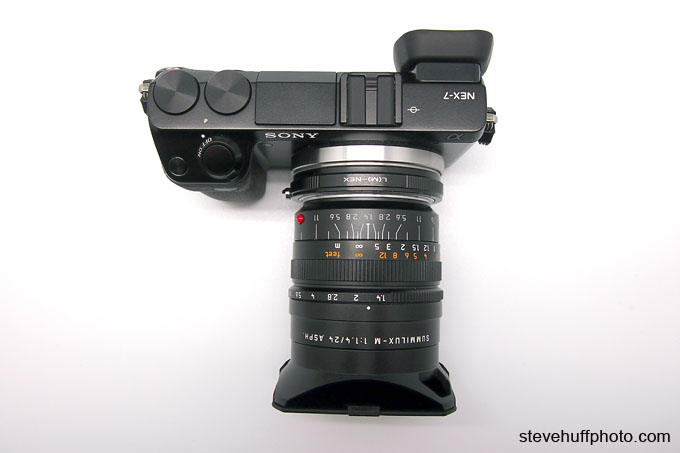
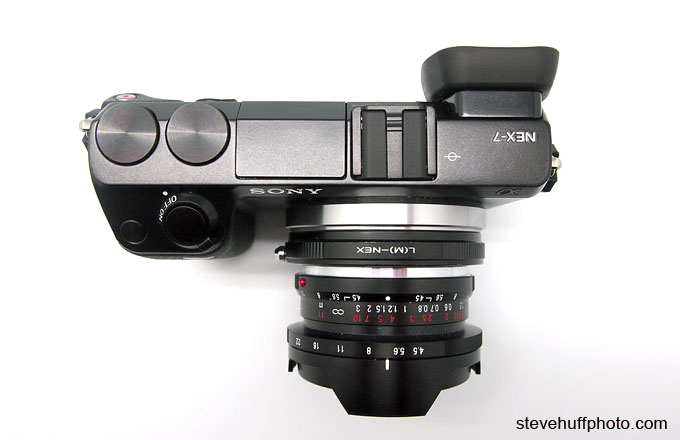
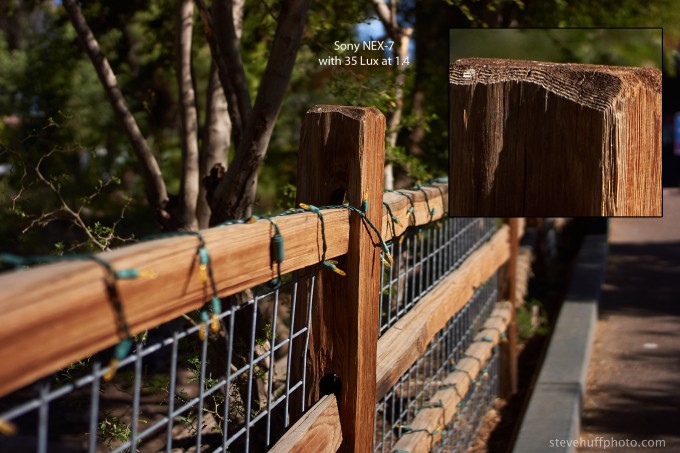

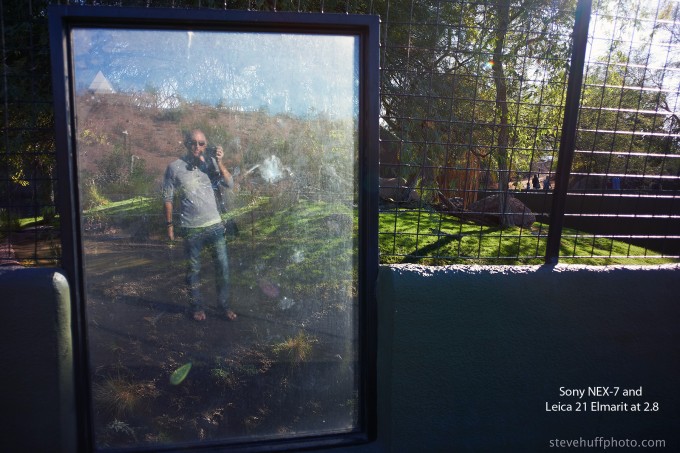
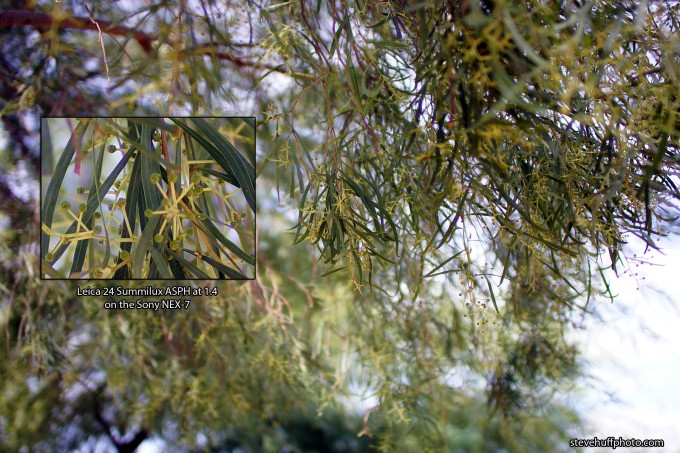
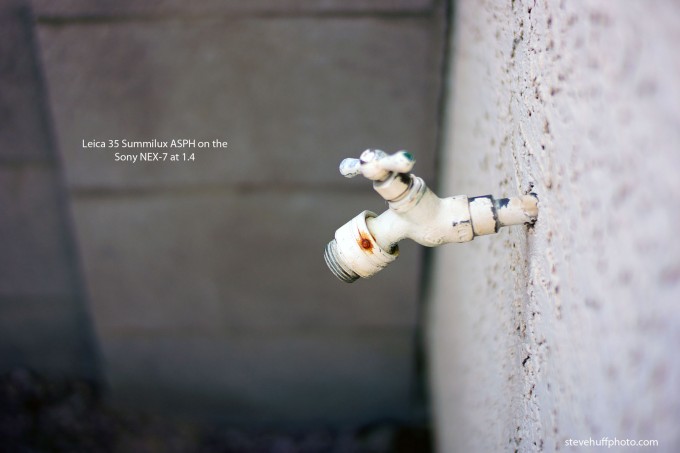
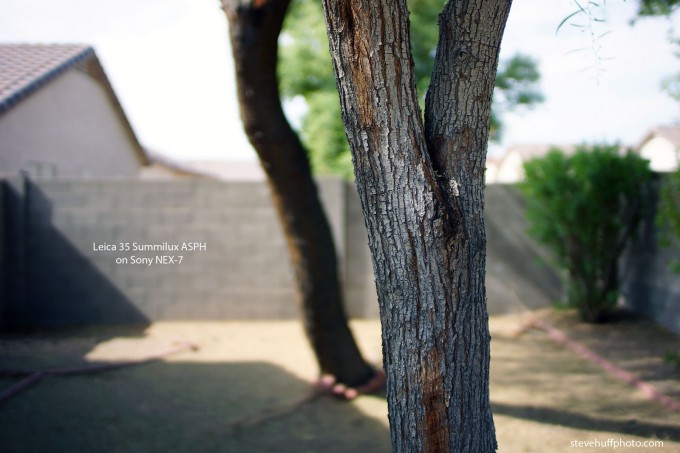
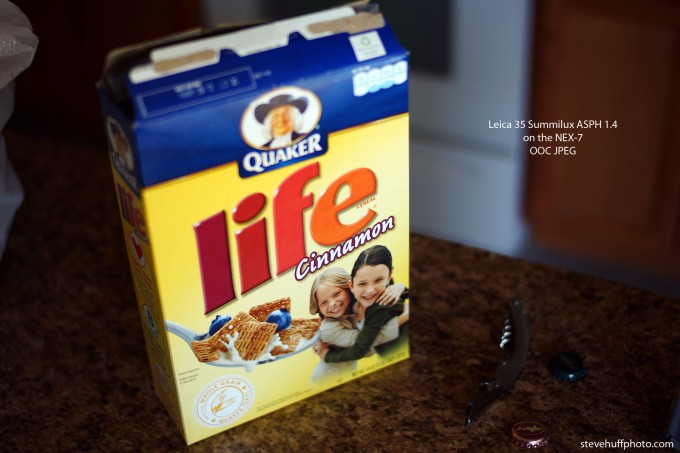

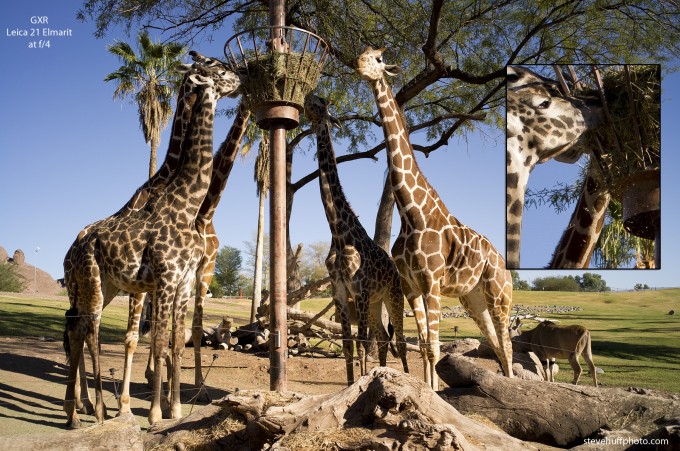
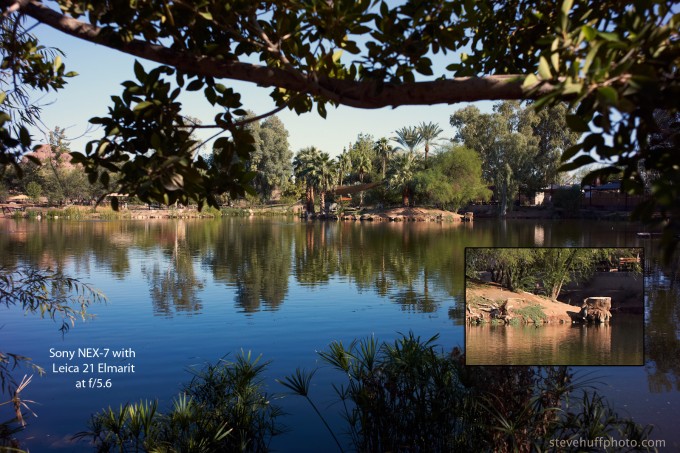
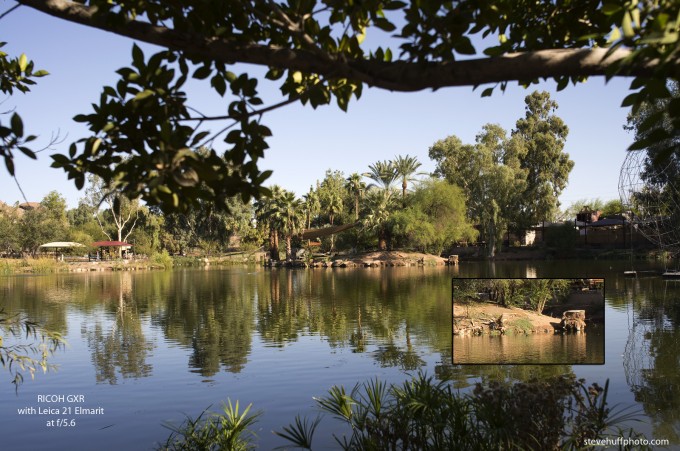


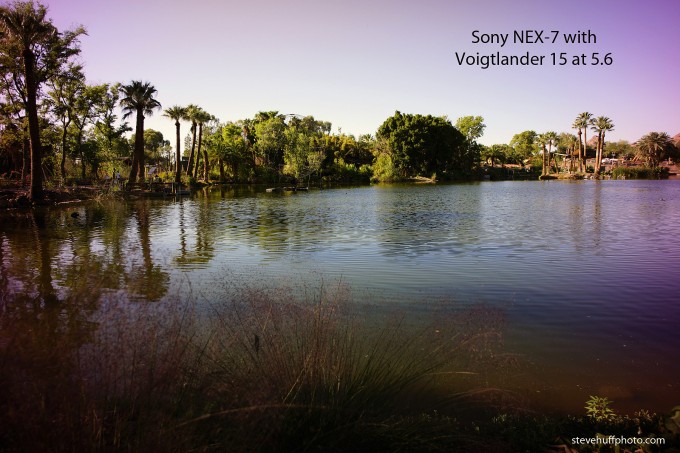
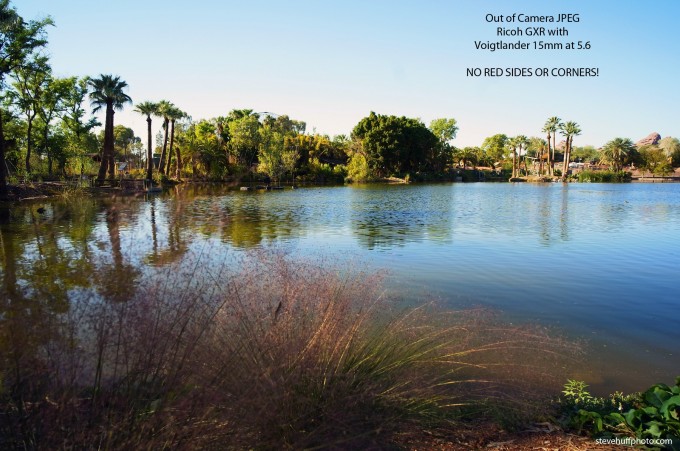
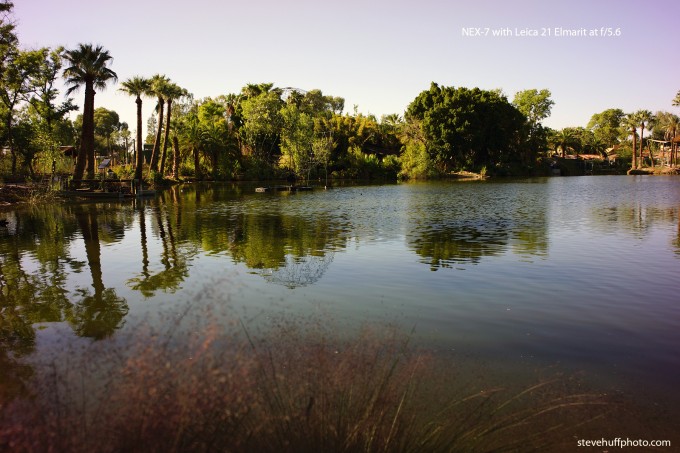
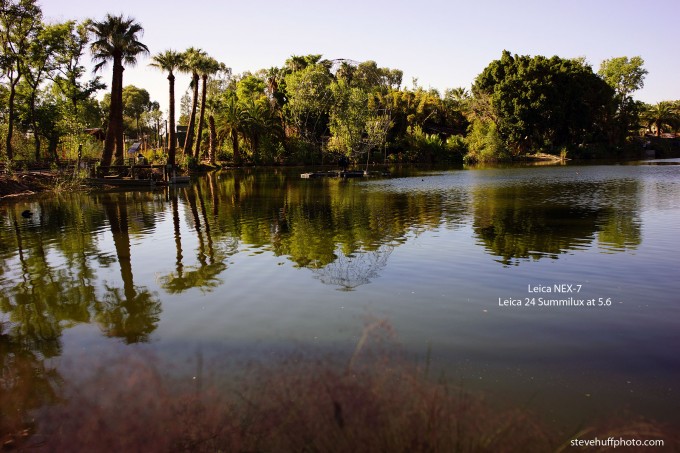
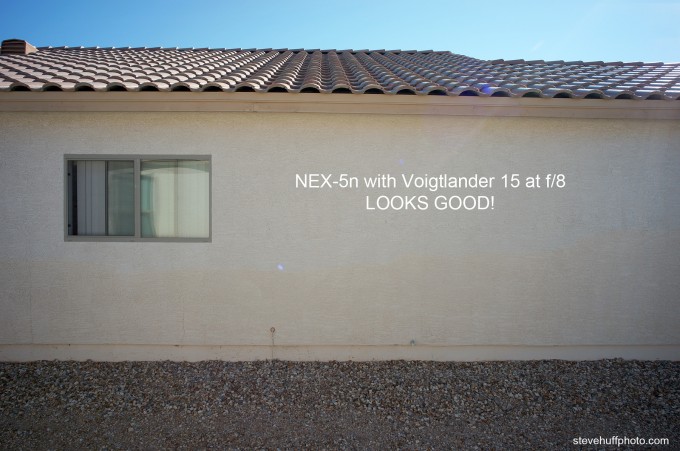
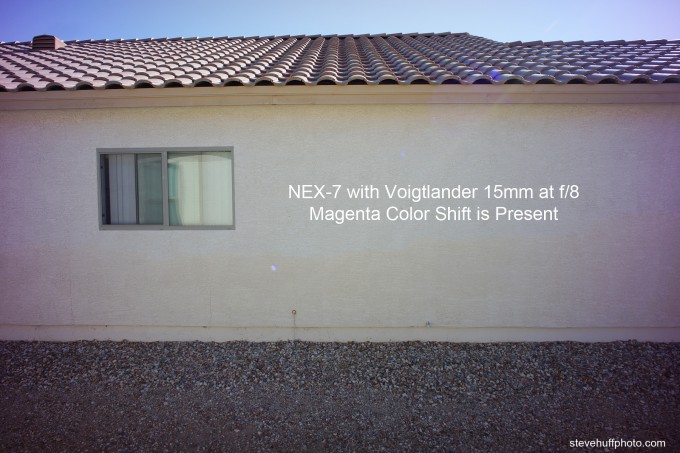
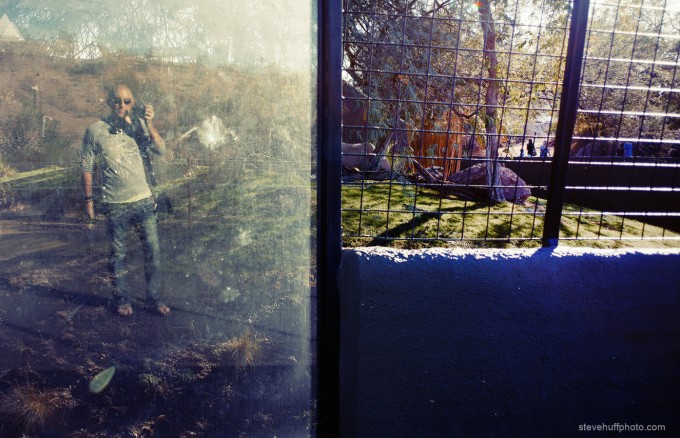
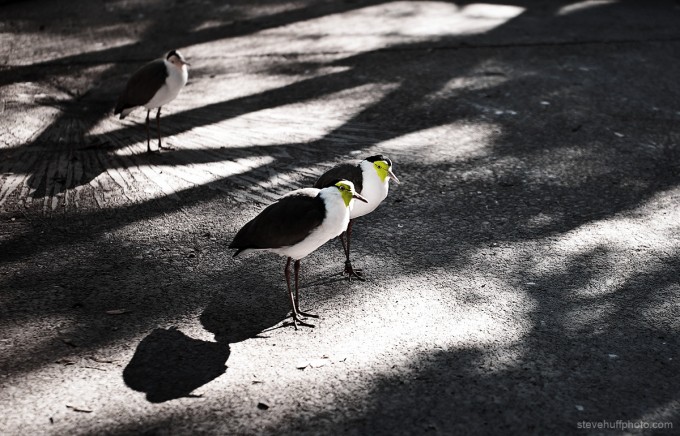
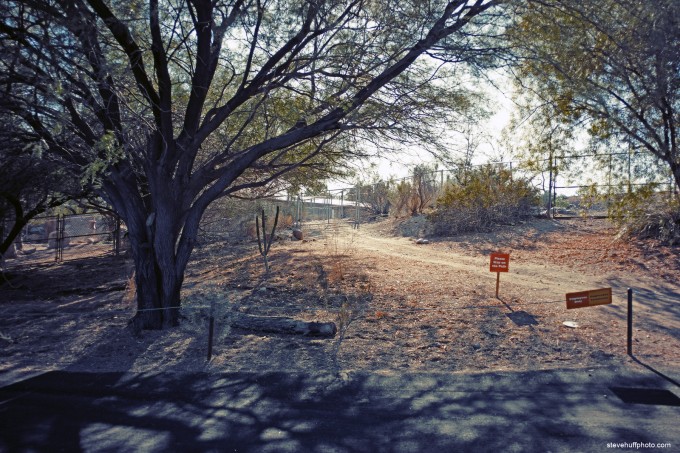
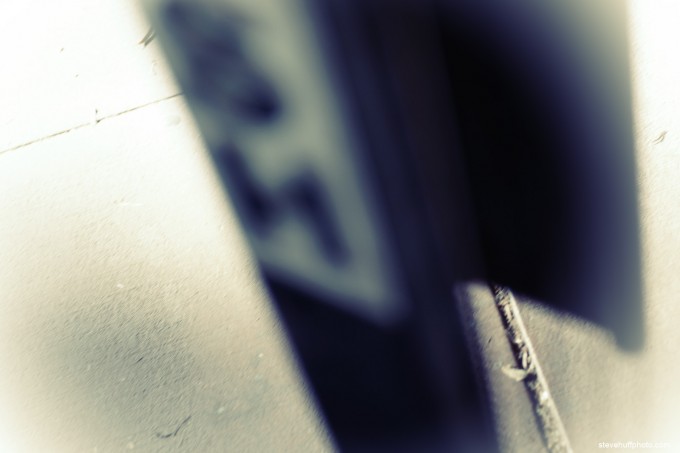
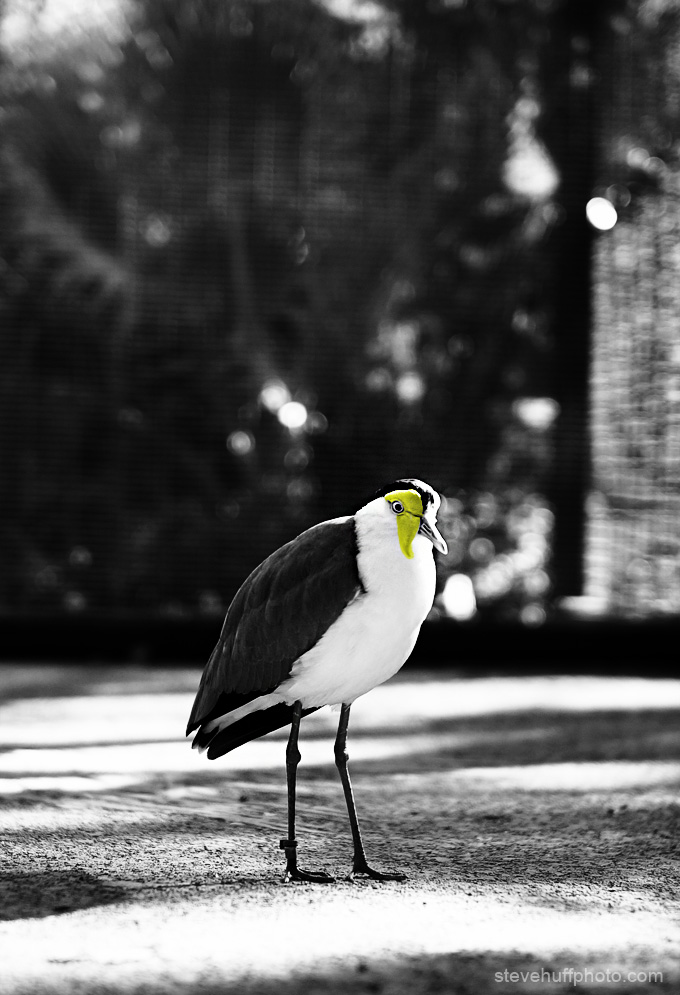

Thank you!
Alfredo Guadarrama M
Toluca, México.
Hi steve,
Apparently the Leica M Super Elmar 21mm can be used on the Sony Nex7 without colour cast. I believe this has something to do with the lens design. However, as i dont have a copy of this lens I cannot confirm.
I recently bought a Nex 7 and would like to get a 21mm lens (Zeiss ZM or Leica M) to mount on it. Can anyone tell me if the zeiss ZM 2.8 or 4.5 has colour shift issues? And also can someone confirm if the Super Elmar 21mm works fine on the Nex 7.
Can this colour shift/cast issue be fixed with a firmware update?
Thanks,
Simon, Ireland.
Thanks, nice review, as I think really helps. One question, have you tried using the Nikon 24mm f2.8? I order one adapter fron China in eBay, 11 usd and my 24mm, 35mm and 50mm NikonD works great. The 24mm does not have the magenta shadow and as I can see, it is pretty sharp, have you tried? Have you tried the Voigtlander 25mm?
I have not tried any other lenses as I do not have access to the ones you speak of. It is good to hear the Nikon 24 2.8 works well.
Steve, thank you for the interesting review. I would like to share a few tips that will give some insights and help anyone using NEX-7. Magenta color cast is quite normal phenomenon and is old almost as wide angle photography, although it was differently manifested on film – vigneting. On very early digital scanning backs existed as green – magenta cast and it was particularly problematic on view cameras when used with strong tilts or shifts. Current lineup of single capture Phase One digital backs suffer from the same problem – green magenta shift which becomes prominent with wide angle lenses and when used on view cameras with tilts and shifts.
As many readers correctly understood, the problem stems from the light rays falling on the chip in non parallel manner. That is why chips with micro lenses handle this problem better.
Still this is not a big deal.Even today, every Phase One back is sold with piece of opaque plexy that is used to cover lens while making exposure. This exposure is than analyzed within C1Pro software in order to create a Lens Cast calibration. Lens Cast calibration is nothing more than created Color Sync profile (for readers to better understand the process, even though there are no additional profiles created) In the typical workflow this lens cast calibration is applied on the top of color space selected, which perfectly eliminate any color cast or deviation. This is particularly important to be captured, analyzed and applied before any final exposure with view cameras, and it completely eliminates that problem.
As a relatively new NEX-7 owner, I have not had a chance yet to play with different lenses, but I use P1’s C1 Pro software as a default for processing of all my digital RAW files (P45+ digital back and EOS 1Ds in my case) Even jpgs could be affected without typical RAW processing. For readers that do not want to invest to this software, this could be easily executed through the creation of color sync profile that could be applied to the files shoot with any wide angle lens. If not used with view camera, than life becomes much easier because color cast will be always the same, and one time made profile could be always used with particular lens. Just nice small piece of any opaque color neutral white plexy could be used. I know there are commercially available filters made for the purpose of white / gray calibration, that will do the job as well.
So, color cast that you experienced and shared with us, is quite common phenomenon and it should not be in any way obstacle in pairing NEX-7 with any wide angle lens.
I have been reading quite a lot about the NEX 7 in comparison to the GXR and the 5n and because I prefer longer lenses for the type of photography I do I have leaned towards the NEX 7. I have handled the NEX 7 and within 20 minutes of picking it up I felt quite at ease with camera and it’s functions. I liked the built in EVF a great deal. I have also handled the NEX 5n and it did not feel so comfortable. I get the feeling by looking and reading about the GXR that I will not feel so comfortable with that.
I have a 35mm Summicron asph which is also reported to have colour cast in the corners which can be fixed with Cornerfix. I do however think there is nothing worse than having a camera or tool that does not feel right so I have decided to buy a NEX 7 and suffer the problem of having to use Cornerfix on some of my 35mm Summicron photos rather than suffer every time I pick up a 5n or GXR camera because the camera does not feel rather right.
I know I’m late on this one, but I was looking again at your ‘Sony NEX-7 with wide angle Leica lenses “A quick test and Ricoh GXR A12 Comparison”, after ordering a NEX-7 and adapters yesterday May 7. My question is: before you shot with the Leica lenses, did you set up in the NEX-7 shooting settings menu the function ‘Lens Comp.: Chro. Aber.”? ( page 24 in the PDF Manual I was just reading). It is supposed to reduce the color deviation at the corners of the screen. I’m curious to see if it really helps for the magenta cast when using 21 and 24mm Leica Lenses. Thanks Steve.
Umm Its the Microlens that make it not work with old lens not the other way around. This is why I own a leaf Medium format back instead of a phase one. Because it works better with old lenses as the microlens isn’t obstructing the lights path to the surrounding photo sites.
I’m also really sick fo people talking about noise MUST BE worse on the higher MP chip. It can be worse but Really? I personally like grain/noise. Just because the chips are the same size doesn’t mean they use the same manufacturing process. Also alls you have to do is good good bebayer software that allows you to properly profile your lens so that when it is de-bayers the chromatic aberration is accounted for.
Hi Steve!
Thanks for your great real world reviews and for this site. It really rocks 🙂
I was wondering if you have had the chance to test sony´s own adapter for the nex series, the LA-EA1?
It enables you to mount alpha and minolta lenses to your nex camera as well as some nice zeiss lenses.
I know you are primarily into m-mounts but it never hurts to ask, right?
Cheers
George
Have not yet been able to try it but did see a demo of it a while ago. Its big but looks like it will work well.
I’ve read several tests where this colour shift (and colour fringing) takes place using the NEX 7 and that includes tests done with Sony’s own 16mm pancake lens. Light appears to hit the crowded 24 MP on the Nex 7 sensor in a different way to the way it hits the 16.1 MP on the Nex 5N. I actually ordered a Nex 7 until I saw these test results and have now cancelled. I’ll wait until they bring out a 16 or 18 MP version. Shame really.
I tried Zeiss 25 2.8 biogon on Nex5N this morning , no color shifting and center sharpness was ok. The edge details of the image were smeared badly at 2.8 aperture (not acceptable to me).
Hope Zeiss 24 1.8 e-mount will be batter in this regard
Hi Steve or any gurus,
I have the CV 15mm Heliar and the Contax G Zeiss 21mm lenses (together w Contax G Zeiss 28, 35,45 & 90mm lenses). Pls advise if the Sony nex 5n will go well with them without the colour shift and corner smear.
Thanks so much!
I shot the 15 on the 5n and 7 (you can see the test on the site) and it was good on the 5n but not the 7. The 21 should be fine as well on the 5n but not the 7.
Hmm… Nex 5n: cheaper, touch zoom (helpful for accurate focusing), better low light/less noise. Nex-7: Hot shoe for mic/flash and the tri dial which I don’t care much about since I’ll be using manual lenses. Hey steve do you think it’s a good tradeoff? More noise, no touch screen, and 300 dollars for the possibility to add a mic/flash? Hard choice :/ BTW does the nex-7 heat up as bad as the nex-5n does? Since it has a slighly larger body, I’m guessing it doesn’t heat up as fast? And can you PLEASEE do a video noise test too? Like a side by side one at different iso’s? That would be sick. You rock!!
Why do you suppose Sony stopped short of a full frame sensor for the NEX 7?
There is about 50 reasond for that.
Thank you Steve for your wonderful website. I’ve currently ordered a 5N with the EVF : best of both worlds compared to the NEX 7 : better sensor and better viewfinder. I’m accustomed to the electronic viewfinder on my E-P2 and I regret that the EVF on the NEX 7 could not be tilted. But, I understand that some people prefer the flash over a tilt-able viewfinder.
I need a Wide angle. Any idea if the Noktor 12mm f1.4 Micro 4/3rds would work on the NEX7, there are adapters.But would it cover the whole sensor? That would be a wicked 18mm equivalent.
Thank you Steve for the very useful education on this issue of magenta cast on NEX sensors. As I bought a NEX5-N precisely with the intent to use it with Leica M glass (as the M9 camera for the “poor”), I was more than interested in testing the CV 15mm f/4.5 on my NEX5-N. I was able to show that there is a small magenta cast visible in some specific situations: monotone grayish tones where the magenta is not overpowered by a strong color such as a dark blue sky or green grass.
Here is the link:
http://www.flickr.com/photos/episa/6315302815/in/photostream
I sent my findings to Steve to have his opinion as people might think that they are safe with the 5N when using wide angles.
So far I have tested and reached the conclusions that at 24mm focal length and above this problem does not exist with Leica M glass. It seems to appear between 15mm and 21mm focal length.[img]http://www.flickr.com/photos/episa/6315302815/in/photostream[/img]
I am planning to use the Contax-G Zeiss 21mm on the NEX-7.
Shall I expect the same color shift? that sucks.
Why is Sony pushing this Megapixels race? they are running faster than their legs can.
I wish they had the NEX-6 , an NEX7 body with the 5n sensor.
All digital sensors have microlenses. The solution to the extreme angle of incidence from wide angle lenses on a short flange distance is to use *larger* microlenses as you reach the borders and corners of the sensor. At 16mp, this is not difficult. At 24mp, it’s practically impossible. Just physically, it is nearly impossible and definitely impossible at affordable yield rates.
That’s why the NEX-7 is not fixed for this, and the NEX-5n is. Don’t buy the NEX-7 if you want to use wide Leica or any other short flange distance lenses from the film era. Just don’t do it. You’re wasting your money.
If you, like me, feel the other features of the NEX-7 are more important, then just use it with E mount lenses or adapted SLR lenses. You’ll never see this color shift and smearing from these lenses.
Ultimately this was a very useful review, it tells you what you need to know if you’re invested in wide angle M mount lenses: Buy the NEX-5n or wait for Ricoh to update their GXR body! That’s my opinion.
I’ll be buying the NEX-7 and all E mount lenses. The only time I use anything wider than 24mm is on a tripod and I use the vastly superior Tokina 11-16mm for that. I mean, once you’re on a tripod, who really cares how big the lens is‽
As a scuba diver and artist who works with color abstractions and someone who practically drills holes in his toothbrush to lighten the load, I was so excited to get a letter from Nauticam that they would have a NEX 7 housing out within 6 weeks of receiving their production camera. Add to this Sony’s email today saying I’d get my camera in two weeks, I started getting hopeful and giddy thinking my Irish luck might hold out and everything will be ready for my upcoming Feb. Asian dive trip.
THEN, I read this article and looked at the magenta shift and fell into deep depression! How could Sony release something like this? The Thailand floods are going to be nothing compared to this disaster. Please tell me this only happens on Leica lens and not Sony’s E-mounts or the Sony Alpha’s with the new adapter. I can’t afford Leica glass anyhow.
HOWEVER, I know enough to realize, something appears dreadfully wrong with the new 25MP sensor as compared to the 5N system to get such horrible color shift: It would appear to be something other then the glass with that MUCH SHIFT, especially quality Leica glass. Hopefully, a firmware fix will clean it up, or I’ll be sending my NEX 7 back within the 30 day trial period, and I won’t be the only one. Have you tested the color shift on E-mount wide angles (16mm pancake w/ adapter) or better yet, the higher resolution Sony’s alpha lenses using the new adapter?. I want the 25MP at ISO 100 for BIG abstract prints, so what I’m after is a small light-weight high resolution package which are the NEX 7’s strengths. Please Steve, tell me this in only a Leica issue (sorry Leica owners). PS. Thanks for the great reviews.
This ONLY happens with Leica glass using adapters. This does NOT happen with any E mount glass of Alpha mount lenses. There is no color shift on E mount lenses. Period!
mr.huff
can you please make a test leica tri elmar wate on nex-7
hi steve, thanks for your review, thats really great n help us to make a choice 😀 btw, have u try with zeiss ZM line up? are these lens have a color shift to on nex 7? thank you 🙂
Looks like no-one told Sony the Megapixel war is over. The NEX-7 would be a much better camera with the 5n sensor.
It seems, that even with the Nex 5 (not “n”) there are problems with the voigtländer 15 and the magenta color shift, as I found in a German blog. It seems the problem is sensor related.
Yes the “5” also had issues with the wider glass but the 5n does not. Not sure why they didn’t fix the 7 as well.
One reason could be that Sony has to get a certain quantity of sensors sold to get costs under control. At the moment only Sony with the A77 and the NEX7 are using this type of sensor. Perhaps Nikon might follow with a successor of the D300s?
It is a pity that Sony has put another sensor in the NEX 7 then they did in the Nex 5n. I use an “old” Nex 3 with lots of Canon FD lenses with great results. Better then I see here with the Leica lenses. Gives a very nice feeling to use al those nice little Canon FD lenses again. I am a little in love with the Nex 7, but I do not like the sensor. 24 MP is way to much for an APS-C sensor. Seems to become the big weak factor for the Nex 7, how can you sell a camera for much more money with a sensor that is worse then your much cheaper models?
Ricoh just absolutely must be preparing an update to their EVF. The need is glaringly obvious!!
In all likelihood, they are preparing a new GXR-II body with a built-in EVF. But who really knows what will come out of the Ricoh-Pentax marriage?
Ricoh is promising to “plug the gap”, whatever that means. Full frame GXR module that doesn’t cost $7000?
Full frame? No thanks, just give us an integrated EVF, Ricoh.
thank for your work Steve but i am surprised not to see a test of the most popular and sold lens the Summicron 2/35 Asph .Test with Nex 7 and Nex 5N.
Perhaps i miss it
I do not own a bunch of Leica glass, nor do I have instant access to it. The 35 Lux performed superbly so the cron would as well. Thx
Hi Steve,
helpful review. Can You tell me Your opinion about dynamic range of NEX 7, 5N and GXR M Mount module? It can be interesting to do some test too. Michal
Since the days of the Elmarit-M 2.8/21, the Leica superwides are moderate retrofocus designs to allow for TTL metering, and this also helps with digital. The Voigtländer 4.5/15 is not and may give trouble on M9/8, too. The 7’s 24MP appear to be more delicate in this regard than the 5’s 16MP. Perhaps for this reason the Sony 1.8/24 is so big.
On the cheap adapters the spring-loaded pin that locks the lens into the bajonet is too small in diameter. This gives some play when rotating the focus ring. Further the flange focal distance might be on the long side. Hence no accurate focussing by scale which is particularly sad for wideangle. For the price of a quality adapter (Novoflex, Voigtänder) you can buy a Sony E-Mount 2.8/16, or a 1.8/50 (with OIS!).
Other than for testing, I wonder why anyone would buy a current $$$ Leica-M superwide lens for use on an APS-C size sensor.
He didn’t buy the lens. He rented for the review only.
Steve,
From what I can see, the NEX-7 has more vibrant colors, more depth and more of a 3D look than the Ricoh GXR A12. I also see that the NEX-7 has more dynamic range, which is very important.
The Ricoh manages slightly sharper images overall due to it not having an AA filter.
I’d give the nod to the NEX-7 (when paired with a lens that can make it shine).
Steve,
From what I can see, the NEX-7 has more vibrant colors and more of a 3D look than the Ricoh GXR A12. I also see that the NEX-7 has more dynamic range, which is very important.
The Ricoh manages slightly sharper images overall due to it not having an AA filter.
I’d give the nod to the NEX-7 (when paired with a lens that can make it shine).
Steve, I read most, but not all of the comments, so forgive me if someone else has already mentioned this:
I’m wondering of the weird purple fringing happens with all wide angle lenses, or only with adapted Leica ones?
I understand you didn’t get to test the 17mm or the kit zoom with the NEX7, but it would be important to know.
If the NEX7 gives this effect even with Sony lenses, then, sadly, it’s pretty much off my list.
Steve,
Thanks so much for the recent articles on the Sony NEX 7 and 5N. I loved reading all of it. Although I’ve decided not to buy either one as I still am using the NEX 5, I like the NEX 7 a lot due to the viewfinder. I wish all cameras still had working viewfinders. I stepped back and decided to reinvest in another M as I had to sell my gear when I moved. now I’m happy to say I will be using a film M again with a 35 cron. Fingers crossed that the gear I bought will be in great shape. Hopefully will get it next week. Meanwhile, i’ll et Sony, Nikon. Leica, Olympus, and Panasonic duke it out for the top digital status, and when the dust clears, may get a digital full frame. For now, I think I’ll stick with the NEX 5 and its soft kit lenses, the Leica D-Lux 4, my Nikon D90, and my film gear. I know it’s not all top notch like some have, but I get good results from each camera, and find that they all have their pluses and minuses. There is no one perfect solution. I haven’t found one yet.
I shoot only RAW. Peripheral blur in the plane of focus is a concern. Color issues and vignetting is of less concern. I’m happy to add another processing step to ‘fix’ the periphery, but can’t fix the smear.
Since last summer I have used the Sony/Leica combination. I’ve been very pleased with the outcome. But I must admit that I miss a viewfinder for my “old” Nex-5. But with a cheap ebay LCD Hood combined with Sony’s latest “Peaking Color” in manual focus mode, it works surprisingly well.
I have been thinking of upgrading to a Sony Nex-7. But with the earlier mentioned bad magenta color shifts on the NEX-7. No way!
I have collected various Sony/Leica photos with various Leica lenses here: http://www.flickr.com/photos/estherpigen/sets/72157625051151842/%5Bimg%5D
[img]http://www.flickr.com/photos/estherpigen/6200942456/[/img]
Is it just me, the results on the NEX 7 look much better than the Ricoh? They actually look great with the 35 mm!
To me the NEX 7 is just a more convenient body to use the superior Leica lens. While it would be ideal to be able to use every Leica lens with great results, I think it is progress that we can use mid and long lenses with great results on a far more user friendly and highly functional body.
thats why I ask if Steve can confirm (or not) smeared corners.
I have to say though that I dont understand people canceling preorders caused by 3 images in the net.
I dont think that would be Steves fault-he just posted what he sees and thinks.
This little “test” has lit up the boards, from RFF to DP, like no other Huff posting I’ve seen. The emotional reactions run the gamut from those who are canceling their pre-orders to those who are aghast Steve, with all three cameras in his hand, has not given any flat shots where they can compare corner resolution, an issue many consider far more serious than colorshift—because colorshift can be corrected PP, while smearing cannot.
I’m in the latter camp. Does the Nex-7 smear corners on retro wides like the Nex-5 did, or not? Such a simple question, so easy to deliver an answer with all three cameras in your possession.
To be fair, Steve is not alone in being apparently unaware of the real world issues using retro-wides on the nex system—lots of folks have been sent Nex-7s and they have also failed in this regard.
We should know within weeks, when serious users with the lenses in question get their hands on a Nex-7. If it turns out the nex-7 does smear corners, Steve’s test here could be considered prescient. On the other hand, if corner resolution is on par with the 5n with retro-wides, this will have to be considered a highly misleading and uninformed test—which caused a fair number of people to abort their Nex-7 purchase prematurely, with consequences measured in extra months wait for a camera.
Hence this test is highly controversial for very good reason.
Yeah lets buy a camera just to have to fix in post-production a terrible color shift issue. What a f-ing joke that is. Sorry, but I don’t think I should have to fix every photo I take just because Sony f-ed up big time.
You do realize that the M9 has worse color shift performance with wide angle rangefinders lenses than the NEX-5n, if you don’t use the in-body coding, right? That’s the case even if you take an aps-c sized crop out of the M9 frame.
If color corner shift is the only problem with the Nex-7, and not detail smearing, then it’s no big deal, and can easily be fixed in-camera like the M9 with a firmware update, or with CornerFix, which only requires a push of the button to batch process. That being said, I’m worried that the NEX-7 is also smearing corners.
Jonny, I think its perfectly legitimate to pass on the nex-7 because you don’t want to deal with colorshift. And Steve has done us a service in showing the issue–I wish he was more clear about his firmware version–I am hearing second hand he had production firmware but I can’t verify.
As far as Sony messing up–do you know how long it took leica to deal with it?
But many of us do not agree with you and are willing to deal with colorshift if we are getting higher resolution overall.
Anyone who cancels their pre-order for this reason is over-reacting by a mile. Why? Because no camera on earth will be easier to resell in early december than the nex-7. You would make money if you cared to. This is because of the floods in Thailand.
BTW: have you ever owned a nex? What are you using with which retro wide angles?
Again, the bottom line is Steve has missed the far more important point of corner smearing. If you can’t see the difference between an issue which is fixable and one which is not, I can’t help you.
“As far as Sony messing up–do you know how long it took leica to deal with it?”
But Ricoh seemed to get it right on the first try. Resolution aside, the GXR module images just look better to my eye, even with the normal focal length lenses.
Who cares about the the corners?. Just go out and take some nice shoots .-)
I fully agree, corner and edge performance with wide m-lenses is the real test for the NEX7.
After quite some time with the NEX7 and hundreds of pictures taken I assume Steve has some files taken with the 15, 21 and 24mm lenses, which could be used to enlighten us on this important question?
As someone who has published a few tests like this one, I can tell you that it’s comments like this one that make a good reviewer want to pack it in.
Aghast? Failed? Misleading and uninformed?
You are way, way out of line. Absurd.
Frank, do you shoot retro focusing m mounts on the nex system? You might be surprised how many do and what an important issue these lense’s performance is on the nex for them. That is the topic of this review. Yet the most important issue, corner performance, is simply not addressed. Not in writing or with meaningful samples.
Apparently it’s OK for Steve to “tell it like it is”, but for those of us who really give a damn and have been dealing with the issue since the Nex was first released, it’s absurd and out of line to point out what is obvious to anyone who bothers to do their homework.
Corner smearing is THE issue with retro wides. Colorshift can be addressed pp. Corner smearing is a deal breaker for professional results. There are hundreds of posts on this point going back over a year at FM, DP, RFF etc.
I’m sorry but if you are not paying attention and post a high profile review it should come as no surprise if this is upsetting to some. It’s not personal. The review simply misses the big question entirely.
The 5n has improved BOTH colorshift AND corner smearing in one upgrade. Hence people associate the two and are cancelling their orders now. But that association is not a foregone conclusion. It could be the case and it might not. All of who care are afraid its true, but because of a few unposted (and I suspect unshot) samples, flat shots where corners and centers are at infinity, or equidistant, we still don’t know.
It’s frustrating, sorry.
My review of the NEX-7 was about the camera and the lenses for the camera system. Contrary to what you may think, everyone buying a NEX-7 will not be buying it to shoot Leica glass with. This is a small number of people when compared to the number that will be sold. So my review of the NEX-7 concentrated on the camera as it is sold, and the lenses that are sold for the system, which is how it was designed to be used. The NEX-7 was not designed to be used with Leica lenses, but rather we use adapters to do so. This article on wide angle lenses was an addition to show how wides perform on the camera when compared to the GXR or 5n. The color shift is there and samples were posted. Corners appear to be a little better with the 5n, GXR when using wider than 24. Also, there is no color shift with the 5n, GXR. Not sure what your complaint is. I am sure once the “scientific” reviews come out you will get to see what you are looking for. Pixel peeping starts getting ridiculous at some point and it is obvious the 5n and GXR will do better when using Leica glass as it appears Sony addressed the issues with the 5n but not the 7. But the 5n and 7 were made for Sony lenses, not Leica lenses. The GXR M Module was made from the ground up for Leica lenses. Period.
Steve,
Thanks for taking the time to reply, and thanks for your fun website.
First, I’d like to ask what you know about your firmware—do we know if this is the same firmware which will come with production Nex-7s?
This is really a crucial question when it comes to colorshift, which everyone seems to think is all about the special microlenses. This is not the case:
“Shading is also known as vignetting. One of the main arguments of Leica for the smaller M8 sensor was precisely the additional vignetting that was introduced by the combination of the steep ray angles at the exit pupil and the shape and position of the micro lenses on the individual pixels of the sensor. The M9 sensor has to cope with the same ray angles but has an optimized micro lens shape.
In addition Leica has incorporated software in the camera that can reduce the amount of vignetting. This technique is not new: many post-processing programs have this option.” Erwin Puts. The Man.
In fact retro focusing wide colorshift on the original Nex-5 could be FIXED in cornerfix, and on the M9 you can see colorshift with lens detection turned off. It’s SOFTWARE which plays a huge roll in both cameras in dealing with the colorshift. The issue of corner resolution is all HARDWARE: the microlenses. Sony improved this why? Because there are many more users of RF lenses on the Nex than you or anyone else in the USA thinks. When you sell an old Leica where does it go? Japan, my friend, likely as not. Who do you think was behind the spontaneous production of adapters for the nex in China? The Japanese market, where the nex is far more successful than here. From the beginning, the Japanese forums were full of LTM and M lenses on the Nex.
When the Nex-7 pricing was announced, users of sony lenses GASPED at DP. However at RFF every owner of the unreliable M9 turned their head. MY BACKUP!!! The driving factor behind the NEX-7 buzz is the idea that EVERYMAN can afford a digital platform for RF glass. Every pro secretly craves an M9. You, of all people should know that. Pros drive the buzz. The buzz SELLS cameras and makes reputations. Sure the masses don’t know a summilux from a washing machine, but they soon know what their camera nerd friend is DROOLING over.
Check your hit count on this test. You think no one cares about wide RF glass on the Nex? Sure we don’t have many or any leica wides: we have CV WIDES, and they are cheap and tiny!!!!! Don’t you get it? The skopars, man! They are 250-300 on the used market and smaller than the sony 16 (though not lighter). And the contax. And the ZM. All under a grand for stellar image quality.
“This article on wide angle lenses was an addition to show how wides perform on the camera when compared to the GXR or 5n”
YES!!!!!!! But we can’t tell because we can’t get a really good look at the corners! Where the HARDWARE is! You think showing a flat shot with details in the corners is to compare performance is too technical??? It is impossible to compare performance without them.
Next time please, take a few extra shots 🙂
Many thanks, Steve, for a tell-it-like-it-is comparison among the three cameras using WA leica lenses, esp with loan cameras where many reviewers elsewhere succumb to wishy-washy conclusions. I suspect many people who have placed pre-orders for NEX-7 are having second thought about it given its worse-than 5N high ISO performance and disappointing coloured corners and edges with WA Leica lenses while GXR and 5N do not exhibit any obvious problems in this regard. Questions (1) I wonder if the colour edge/corner can be eliminated on the NEX-7 by future firmware updates as Leica did with M9 or the microlenses on NEX-7 are to blame here. (2) I would also like to know if the lens correction data was deployed on your GXR for the VC 15mm to remove the coloured edges and corners. (3) Have you used any of these lenses in this review on NEX-5? And any coloured peripheries on NEX-5? Keep up the good work. Thanks
I dunno but as mentionned previously even Leica struggles to get it right… I will test my copy with my Zeiss 21mm and if it does not work…then Cornerfix or Phase one program will fix that for me…softness on the edges? We’ll se if it is a real bad thing or just a mgnifier type of loss… Anyways, I still hope to get it quick…
Cheers!
Steve, thanks for the reviews, esp. the 5n vs. 7 shots of the white wall. Looks quite shocking but it only took me a minute in PhotoShop to correct it. And there are plug-ins that would do it better and faster no doubt. Lots of information to digest but those of us with lots of M-mount lenses have several neat choices.
Thanks for the review.
Steve, did you also compare the Leica wides towards the Nex 16mm or the Nex kit zoom?
Can you confirm that the problem is not only color shift but also worse IQ in the corners when using the Nex 7?
This comment is a bit OFF subject, but I thought may help any NEX or SONY user ? with a stuck or dead pixel. I just got the 5N I have a NEX7 pre ordered. In any case my 5n seems GREAT so far..BUT arrived with one dead or hot white pixel. I know hot pixels are a fact of life with any megapixel camera seems ESPECIALLY Nikons haha using Sony Sensors!. In any case This small help article FIXED my dead pixel and it’s perfect now. Thought this may be of general help and “I apologize I’m posting it HERE but didn’t know where to put it.”
So IF you have a hot pixels on your Nex THIS worked for me..Hope it may help somebody here.
From the how to:
Sony digital cameras all share the same approach to hot pixels and stuck pixels. Apparently, once a month, when switching off, the camera will shoot a black image and look for stuck pixels to update the dead pixel map of the camera. The swithcing off is longer when this happens (the red light will blink a little longer), but after this step the problem is automatically corrected.
It seems that if you want to correct it by yourself, the only thing that you have to do is to change the date in the camera menu, move it forward at least further than the next 1st day of the next month, switch off the camera (let it do its little game of red light), switch it on again, shoot one picture, go to the menu and change the date back, then switch off the camera.
After this, your Sony camera updated its hot pixel mapping and knows where to expect them. It will magically remove them from the picture and just interpolate values from the neighbouring pixels. Instead of having an ugly white spot, you’ll get a microscopic and invisible loss of resolution (one-pixel resolution loss out of 6 to 12 millions, it should be acceptable, eh).
Hope this may help somebody here..again sorry it’s being posted in the wrong place just tryin to help ppl here. Worked for ME anyway..
You shouldn’t post comments that are not facts:
@Dargle: “I know hot pixels are a fact of life with any megapixel camera seems ESPECIALLY Nikons haha using Sony Sensors!.”
I never experienced dead pixels on any of the Nikons I have owned and nor have my friends.
I have experienced dead pixels on my Olympus PEN E-P1, but that was easily fixed from the menu. Don’t recall where in the menu, but it is there.
Hi Anders, Believe me I meant no harm. I can only tell of my experience with Nikon so far. I had a D90 you can google it, there are TONS of users who complain or complained of hot pixels with the D90. My D90 which I babied and really didn’t even use that much had about 4 BIG hot pixels..all different colors. So, I got a D7000 out of the box it has a green hot pixel already after less than 300 shots only. I am glad you have had no issues :)..but (Nikons and hot pixels) are discussed in a ton of forums. In some other way I was just trying to help Nex users ACTUALLY who may have a hot pixel or two, as the fix I wrote worked so well for me on my 5N.
Lastly…I also own a Pentax K-5, again, THE Sony Sensor. Tell you true the first K-5 I returned, as I was gonna JUST keep my D7000. I must have been crazy to order both in the first place I JUST COULDN’T decide which one I liked better, so got both, knowing I’d e-bay one of them later if the return period expired, which it has..
I reordered the K-5 this time body only, with a better than lens. I bring up the Pentax because BOTH my K-5’s had hot pixels at least 2 each, RIGHT out of the box.(SONY SENSOR). Luckily Pentax has BUILT in Pixel mapping so the hot pixels were gone in a flash.
Yes any camera can get or will probably have hot pixels sooner or later..you can read Ken Rockwell’s take on this. But I brought up Nikon cause it was MY experience with my 2 Nikons and just google Nikon and hot pixels you’ll see a TON of people who have this issue with Nikon, AND I brought up Nikon cause WHEN hot pixels should they occur start to bother you,.there IS no simple fix like the Nex offers (re: my post) OR A K-5 which has the built in mapping as I think Olympus and Panasonic have as well…I hope you NEVER get hot pixels ..but you probably will..:(
Hi Dargle I’m sure you meant no harm, but you don’t have the statistics to prove your claim. It is always the bad stories that are heard. You can find stories on dead pixels and other failures on any camera on the Internet.
Right now there are stories about a stuck shutter blade on x100 and there are a lot of stories about failing Leica m9s, but that doesn’t mean that it is but a few that fails compared to the number sold.
There may of course be a bad series now and then, but generally I don’t think it is the case very often.
I know it is no proof, but I have owned a d1, d2h, d80, d90 and a d700 and none of them have had problems with dead pixels. Haven’t had any problems with the x100 after several thousand shoots either.
The strange thing is that Zeiss M mount (18-21-25-28-35) do not show magenta corners with NEX-7.
mururoa — how do you know that ZM wide angle glass in conjunction with a NEX-7 body isn’t suffering from colour cast? Can you back up your assertion with a useful link? What little testing I’ve seen out there does show some magenta cast with wider ZM glass, which is what you’d expect.
Count me in as one of those that don’t care about colour shift – that can easily be removed in post processing and potentially also by Sony in a firmware update, much as both the Ricoh GXR and Leica M9 deal with colour shifts and vignetting using in-camera software. While another processing step is always a hassle if not needed, I’d consider it a good trade off to accept if the camera meets my other needs. Neither the GXR or NX-5N quite do.
What I and many folks ultimately will care about is the much more important potential impact to image quality – namely smearing and unacceptable loss of resolution at the edges, if any. It boggles the mind that at this late date we still haven’t seen, anywhere on the internet, a set of useful images with wide to normal lenses looking at this aspect of image quality to prove or disprove this as a concern. That’s a shame since it is relatively easy to do and would be hugely useful to camera consumers ahead of whatever limited launch is possible given the flood situation in Thailand.
It is great that Steve’s review has sparked so much discussion. Wouldn’t it be nice if somehow we could answer this one outstanding but, to a great many, important question?
ps: I recall a great shot of Steve’s that proves to me at least that hunting down brick walls for checking out edge sharpness and detail doesn’t have to be boring or artless. Love this:
http://www.stevehuffphoto.com/wp-content/uploads/2010/02/amazinglightfactory-1-680×453.jpg
Thanks Steve for great reviews, particularly this review! Hopefully there is more to come from you on Sony Nex-7 with Leica glass… One thing that I hope that Sony will take your review seriously and upgrade their software (if they could) to eliminate the sort of vignetting issue. Maybe they wont, since they are also selling wide angle Zeiss E-mount lens. Let’s hope Sony will overcome this problem for those like to have Nex-7 body with Leica glass. Big question mark here?
Steve, one question, when testing all these shots, are you sure you are in the correct white balance? Maybe mistakenly turned one of the Tri Navi dial while you are shooting out there. Haha….
Steve, Thanks for the great review. I own a Nex-5 and waiting to upgrade to a Nex-7 but now it seems that Nex-7n is the way to go. I am very amateur at photography. I have a CV 28mm Ultraron, Leica 35mm Summicron, CV 35mm F1.4. So I have comparison of 28mm Contax G Carl Zeiss @ F2.8. (Don’t have the expensive glass.
I was just wondering if your wobbly adapter might be the cause of the color shift? I re-read your review, you mentioned you left your good voigtlander adapter at home with NEX-5n and used the cheap ones. Could that be the problem? However I saw your comparison with the 5N and hopefully you are using the same solid adapter. Just wondering….as I don’t have a problem with the JPEGS and RAW. Is this shift only on the JPEGS?
Anyway, I hope your review continues….
This is interesting. I ordered the NEX7 to use it as a temporary camera instead of a M9. And spend the rest of the money for Leica glass so I could shoot this glass with a good camera like the NEX. After saving I would buy a M9 or hopefully M10 and use the NEX7 next to it.
But now I’m going to think twice and keep an eye on all the reviews to come before I make the step. I hope this problem will be fixed in firmware. Thanks for sharing Steve!
Why would Sony invest manpower-costs in programming correction software for Voigtlander glass?
Folks, wake up, even Leica with it’s M9 didn’t solve this 100%…….
When there is a chance to test SLR-wides on the NEX7 – this would make more sens do to the uncomplicated register, but M lenses?
It’s not really needed to test SLR lenses: the angle of light hitting the sensor will always be more perpendicular, due to the free space between the lens and the sensor. In any case, just check regular reviews of the lens: it will perform about the same way on the NEX as on its native mount (assuming, of course that its mount is still active).
As crops of the corners show, detail resolution takes quite a drop when this fringing takes place, comparing the 7/5n. So I guess you might get rid of the color cast by SW/firmware, but details??
Steve, I would be very happy if you could write just one line which color rendering was more truthful (7 versus GXR)?
Steve and all
I think it is a bit early to condem the NEX-7 with really wide lenses (i.e 21 mm, 15mm & wider). It does not appear that you had the fringing in evey image using the 21mm posted. So it may be that an incompatibility issue with the combination of your lens & adapter on this camera. A different camera or adapter may bring different results.
Concerning the comments about micro-lenses on the camera sensor, all sensors have micro-lenses. The difference is that Leica and now Ricoh has the micro-lenses shift off the centerline of the pixel towards the center of the frame, and the shift increases the farther away from the center of the sensor the pixel is.
PaulB
Steve,
Thanks for your quick review. But, the result is really interesting. Nex 7 seems do not have any refinement on RF (& wide angle) manual lens versus 5n. Maybe, Sony wants NEX 7 user to use their E mount lens, ha ha.
Steve,
Very interesting and valuable comparisons.
One question is how much of the magenta fringe could be a software problem. I know the M9 had a similar problem but it seems to have been largely resolved with a software upgrade.
Steve,
I enjoy your site and your passionate, lively reviews.
I have been avidly following your Nex 7 reviews and despite your latest comments, I am still very interested in the Nex 7.
As a Leica guy, I own a lot of Leica glass. I have spent a fair amount of time thinking about which Leica lens would be the best choice for the Nex 7.
Right now, I have closed in on the 28mm 2.8.
This lens was put forward by Leica along with the release of the M8–and is an excellent, well-reviewed lens. On the M8, with its 1.3 crop factor–it was roughly equivalent to a 35 mm lens. On a Nex 7, with its crop factor of 1.5, that would bring it up to about 42 mm. That’s mid-way between the two most popular focal lengths, 35 and 50 mm. By your measures, it would have virtually no color shift. And tiny as it is, paired with the Nex 7, what a potentially wonderful combo for street photography!
Can you get ahold of one and review this combo?
I did review the 28 Elmarit on the M8 over two years ago (see the Leica reviews tab at the top of any page), but there is no way to get one to test on the NEX-7 as it is already packed and ready to ship back to Sony. Sorry! I would imagine that the 28 would be fine on the 7 though.
Wait — you said you shipped the Sony back… but it’s been on the kitchen table all along…. sneaky !!
Going back any day now though…
I’m waiting for the Nex 7 to use my Zeiss 28mm biogon lens on it. After reading Steve’s post about the color casting, I was considering getting the Nex 5N instead. But I think 28mm should still be okay. The 5N with the hard to find and expensive EVF would be about the same price. Oh well, we’ll see.
I’m in the same boat.
I’m on the list for the Nex 7 (I’d go for the Nex 5N, if I didn’t have to also buy the EVF and if its ergonomics were better).
I was intending to use a 28 mm lens, and I suspect that this is something which will be sorted with a firmware update. Red edges have been a problem with certain lenses on the M9, and the latest firmware update seems to have sorted the problem I would imagine Sony will sort this before the final release.
Alternatively, wait for a 7N or the Leica EVIL (that won’t be cheap).
I will probably go for the Nex 7, and restrict myself to my Leica 28, 35 and 75 glass.
Thanks for the comparison Steve… I used my NEX5 with 21mm Zeiss, I do not remember shocking color shift…. Hum… maybe I should stick to it…
With the CV lenses, with the old NEX 5/3 trust me its there just as bad.
As for the NEX 7, my pre order is cancelled; just as well as since the floods there was a 75% I would never see mine despite ordering in early september. The 5N is truly the winner over the GXR, whos color cast is markedly worse than the 5N without tedious profiles, Ricohs EV and peaking is junk too.
Wow!! The Voigtlander color shift is creating an issue. I have been using the 15 on the 5n and love it.
I have pre-ordered the 7, but certainly don’t like the results you posted with that lens.
Is that something you think Sony can fix in firmware? I will be really disappointed if I can’t use wide lenses on the 7.
Steve, you mentioned about GRD IV to review, did you already get yours in?
I preordered mine at B&H, but still no word.
Can’t wait to see your review
Cheers
Steve: I bet you are almost wishing you hadn’t posted these pics, which is creating all these good questions LOL! I can echo the questions others are asking. Can you work with Sony to pinpoint the actual CAUSE of the color shifts? For example: Is it a retrofocal vs. non-retrofocal lens design issue? Is there any solid technical data that supports the claims that it a microlense/wide angle issue, or are people just making guesses. Is it a firmware fixable problem? Is sharpness impacted at all or is it simply color shift? I can appreciate your focus on avoiding technicals, but if there was even an issue where we need to “go there” – this is it. This is great work Steve – thanks, we’ll buy the beer if you can keep energy on the issue as there are thousands of us that want to use Zeiss and Leica M glass on this NEX7 baby.
Steve, thank you for the news.
It is good to have choices and options. As I have both systems on order I feel like a corporation backing ALL the candidates in the election – outcome doesn’t matter, they win either way. 😉
What could be deciding factor for me is how well the viewfinders work with me wearing glasses. For comparison, I find Canon 1ds viewfinder not good enough for MF, but Nikon D1s I tried looked much better. I might even switch my DSLR system because of that. I have not looked at Sony A900 because of lack of Live View (which has been saving my butt on 1Ds).
So Steve, do you wear glasses, and if you do – how much of VF can you actually see? If you don’t – just take a look at them though sunglasses for us – that information would be very valuable to all us spectacle wearers.
hi Steve thanks for that review. V disappointing for a soon to be nex 7 owner but do you think this is a Leica wide lens issue on the nex or an issue with wide manual lenses full stop? I have some rokkor wides 20mm/24mm and would be willing to try voitglander or zeiss wides or do you think the same issues would arise? Would love to hear your thoughts. Cheers Nick
First of all thank you for your review(s). You’re one of the only guys out there whose reviews don’t get too technical. I much prefer a “real world experience” review to an über-technical one. I’m a photographer, not a scientist or engineer.
I have a brand new NEX 5N in my hands that I was just about to return and wait (impatiently) for the NEX 7 due to it’s better ergonomics and built-in EVF. However, this test freaks me out a bit.
What is your opinion having shot a variety of lenses with both cameras? My main kit with an NEX 7 or 5N would be a Voigtlander 35mm 1.4, and a Sony E-mount 24 1.8 lens. Do you think I’m in the clear if I don’t go with a wider than 35mm M-mount lens?
Again, thanks for the quality reviews you do here.
A couple of comments
When does 5n have less shift than 7? This may be strictly due to the larger pixel size of the 5n, if the wells are deeper, having the light come in a sharper angles, may not matter as much.
However, it also may be in the firmware. The 5n has stable firmware, which may be automatically correcting for the color shift. This is VERY easy to implement in camera, and could be another reason.
That being said, SONY – please implement automatic color shift correction in camera on the final firmware or the first update.
It’s not only color shift but details reduction as well.
Speaking of GXR, DigitalRev just posted their review on the M-mount module for GXR.
http://www.youtube.com/watch?v=E1FCwJMdWVM
Thanks for the quick comparison Steve. Again the 5n shines? Hmm everyday this little “monster” seems to be doing better and better. The colour signature of the Ricoh is great!
Very excited for all your upcoming reviews. The Nikon 1 system was dissapointing at first, but lots of shots I’m seeing from users are pretty good as well as the tracking performance.
I’m also very interested in the PanaLeica 25mm DG. Exciting times!
Hi Steve, this is AWESOME, the comparison that many of us have been waiting for, and a true reason to make hard choices. While the NEX 7 seems to be the best ergonomic/functional fit of the bunch, the NEX 5N has been low ISO output and less to minimal color shift with wider M glass…I am still struggling with the fact that NEX 7 seems so sexy, but I am somewhat glad that I haven’t committed to it yet….
On the other hand, the GXR has been a real winner for me, and your experience confirms my own. I have shot tihs camera solely (not picked up an M body for over a month now), and I continue to be very pleased with the output and M lens compatibility over a wide range of lenses and circumstances. If Ricoh would put out a comparable EVF for their GXR, I think they’d win the game as a M mount backup. However, Sony’s EVF and Ergonomics are so good that despite the lower IQ, some may choose it. I am still tempted, but the fire has been squelched a lot, since I am “all in” with regards to Leica glass and don’t really want to start building an E-lens set up.
The NEX series seems to thus have some room for growth: better, smaller lenses, better M mount capabilities at its high end, improved clarity through reduction/elimination of a high pass filter, better microlenses for the NEX7, and faster AF. If it can acheive this, I’ll be sold…until then, it’s lookin’ like the GXR was the right choice for me…
Thanks again, bud!
Thanks for all your efforts!
Regarding the different color rendering of 7 versus GXR:
You were there -), which rendering is closer to what you saw?
Thanks for your great and honest review as usual! So I deduce the best choice for now is the 5n and wait for one year more…time to Sony to produce the the Nex 7n using the same shutter of 5n …Anyway your reviews are very helpfull! Not like the blabla of the scientific test that not reflects the real life!
Here’s what it comes down to:
There’s no poor man’s Leica.
There is no substitute, only varying degrees of compromises.
+1
This is true but Leicas are full of compromises, too (more so than the alternatives which can mount the same lenses).
A Leica is the only camera that can utilize the full potential of M-mount lenses. Sure, with adapters other cameras may do some things better in some ways, but none can utilize them fully like an M9 or film based M camera, in the way that the lens designers intended.
well put, Cristian.
You use focus peeking with the manual focus lens but can you also use focus magnification with manual (focus) lenses ?
If you can, I couldn’t find it.
Well you could with the NEX5…Peaking was enabled with the zoomed focusing screen BUT… You may not see it well as the light dots might not be in the filed you are looking at… If you play with the focus, you will see the dots coming and going as your seen get more or less in focus. Best thing, is use peaking to focus on the eye then zoom to focus on the cornea instead of the eye lashes for instance…
Cheers!
It seems 5N is the way to go with Leica lenses if don’t want to spend a lot on the camera body. Unfortunately, the EVF for both Ricoh and Sony is not cheap.
Thanks for the excellent work.
Yes, I just updated this with a shot with the 5n and the Voigtlander 15 – NO SHIFT at all.
I second Dirk’s comments. As I continue to read your coverage, it seems like the best things going for the Nex7 are the viewfinder, the very fast shutter and the external design with the easily accessible dials. The super large sensor doesn’t seem to add much. Too bad the EP3 doesn’t have a superior viewfinder. I like the size but it’s quite an investment for the issues.
On to the Nex8 or 9 or…The Fuji with interchangeable lens and less complicated, more easily accessible controls.
Thanks again for the continuing and thorough coverage. It is very helpful
because I raised the question: found this gallery of 5N shots with the 15 and 21mm CVs amongst others. No color shift whatsoever:
http://www.pbase.com/scho/nex&page=1
huh!
If Stephen’s comments are correct why do the 5n and the 7 perform differently? Same size sensor.
Do you have a 5n to hand to do the same tests Steve?
And Stephen based on Steve’s results only one of your lenses will show noticeable colour shift. Your 15. Perhaps you can live with that?
Just added a comparison shot with the 5n and 7 using the Voigtlander,
Thanks for the test Steve, this is very good and shows why having a mdoule dedicated to a specific lens is always better tahn something you adapt to work.
I have one question though since I keep reading this. You say the NEX7 is better due to the peaking on the Sony. maybe I am missing something but the paeking on the Ricoh is identical in Mode 1 except from the colours you can select on the Sony where on the Ricoh it’s just white but the Mode 2 (high pass filter peaking) on the Ricoh is in my experience way superior to the peaking mode and allows for both faster and more accurate work, especially in low and very bright light.
So after all this, my question is what is so superior on the Sony NEX peaking that I missed during my limited time with the NEX-3, 5n and 7 in the shops?
It would help to know why the peaking mode in the NEX is considered better by you?
Thanks.
I find the peaking much better on the Sony NEX5n and 7. First of all, the colors help. With white it is tough to see and also, on the Sony you can see the effect MUCH more clearly. With the Ricoh I struggle with Mode I. Mode 2 I am not a fan of at all. Trust me, the peaking is much easier to use on the NEX-5n and NEX-7.
Thanks for the reply, so it’s basically down to the colours.
For me there is nothing better than Mode 2 once you get used to it so I can’t see the colours really being of that much help. Especially not when I can magnify part of the screen with the Ricoh but don’t seem to be able on the Sony.
While I think the NEX7 looks great and has some nice features, the GXR is simply the camera to go for when one wants to use M lenses since the NEX5n simply does not have the controls as well implemented as either the GXR or the NEX7.
Actually it is not just the colors. The NEX peaking is just implemented MUCH better than Mode 1 or II on the GXR, and it could even be due to the EVF on the NEX. Just so much easier to use and nail focus with IMO. Maybe Ricoh will release a new EVF soon, thats all I can hope for. Better yet another body with a nice built in EVF. 🙂
Ah, you only use the EVFs?
I always use the screen so this could explain why I was not blown away by the NEX implementation. The EVF on the NEX7 is great but not as bright or big as on the Fuji X100, which still has IMO one of the best EVFs were it not for the horrible slowdown and lag in low light and freeze when half pressing the shutter in good light. The Ricoh one is 2 years old now so it shows, I hope they will release an updated one soon.
What more control do you need shooting manual M lenses? What’s on the 5N is plenty for using M glass. BTW, the Sony EVF is amazing peaking with evf is a totally different experience.
I’m with everyone, that Ricoh should have a new Body. After all that’s the _other_ benefit of having a modular system.
nex’s peaking is more contrasty, easier to see the peaking lines along the live view. GXR’s peaking (mode 1) is more spotty ( i used both)
i prefer GXR mode2 for portrait/long lenses, sony’s peaking for medium/normal. on wides you dont need focus assists!
Funny that you say that, because I find the exact opposite true.
I own both cameras and the GXR is, imho, way superior in terms of focusing aids. Let me explain why:
Mode 2 on the GXR is VERY effective and for me, much easier to see than either Mode 1 or the NEX peaking. On the NEX I have to go forth and back to determine when there are the most colored pixels jumping around. Mode 2 most of the time allows me to asses focus faster.
The second thing is how it is implemented in the workflow. Half-pressing the GXR shutter disables all aids and zooms. So what I usually do is, I have my screen on 4x zoom, focus, halfpress the shutter to check the composition and shoot. Very accurate, very fast.
One thing that frustrated me with the NEX was that I was not able to focus the 28/2.8 on peoples faces reliably, even I have the EVF and used peaking. I always needed the loupe, that is not as convenient to activate (only a slight difference, but it is there) and doesn’t behave as nicely in conjunction with the shutter press.
with the GXR this just works. I was really surprised, because due to the weaker video output of the GXRs sensor and the low res EVF I expected it to be harder, but thats not the case – for me.
all in all the GXR is a way superior camera in my eyes. Much better ergonomics, much nicer behaviour with a few wider lenses, a standard hotshoe, much better in-the-hand-feeling.
The NEX is an iPhone with lens mount, as somebody already stated. I like my iPhone. But for somebody who likes to use real cameras and does reportage, the GXR is way ahead.
Have you tested the NEX 7 with the 18-200 mm lens? I have a NEX 7 ordered with the 18-200. Some reviews on the Sony website praise the lens, others say it is soft. Any opinion ?
I do not own the 18-200 but have heard nothing but good things about it. It should do great with the 7.
Not great. I was hoping for a nice backup camera that could handle a small Zeiss or Leica wide angle, like the 21mm. I don’t want to mount my 35mm on it because that is close to the 50mm that I would carry on the M9. Ideally Sony would have a nice, small pancake that would come with that camera. The 24mm is too large for me. I would stick with the M. The only thing that really makes it interesting are the dials and the viewfinder. Otherwise I would have canceled the order already and would have ordered a 5N. Steve, if you would have to decide on a small interchangeable lens camera with a nice wide angle in a smaller package. Would that be theE-P3? D!RK
Well, the 5n would work as it does well with even wide angle lenses. The E-P3 has some amazing lenses available and to be honest, it is the camera I use most of all these days, because of these new lenses (and the body, controls, etc).
Maybe this is placebo, but I never thought a dead on focus super sharp image from a Leica lens can be a bad thing. Maybe the Leica glow comes from always missing the focus by a hair lol.
Thanks Steve, Very good insightful images and tests.
Thank you Steve – exactly what I hoped you will do. You confirmed what I have expected. Ricoh should really build on this success – there are mane photographers out there who either want an affordable digital body to use their M-lenses on or just want a backup to their M9.
As the voices for improvements are getting louder – Ricoh should really listen and bring second generation of the GXR body with EVF and some other improvements. In the next step a larger M-mount module (maybe 1.3 crop factor or even full frame) could follow and even be offered parallel to APS-C M-mount module (as those two would differ in price quite a bit guess).
I really hope Ricoh will continue to improve the GXR – it is a great concept (I should finally get one)
Hi Steve,
Many thanks for this post, it’s quite impressive to see how the Nex 7 performs with the 35 summilux.
Regarding the 21 elmarit, recently I bought a second hand pre-asph version, tested with my Nex 5 and got great results without any magenta color shifts in light sky. I also tested 15 CV and got a bit of magenta color shift but quite sharp images, even sharper than the 21 elmarit.
By the way my favorite leica lens on the nex is the Summicron 90 pre-asph, it’s the best lens for portraits.
Cheers!
I’m really happy with my GXR mount + ZM 35mm f2. I’ve sold NEX5 for the Ricoh. Much better “Zeiss” color and drawing and sharp edge to edge. Some shots: https://plus.google.com/u/0/?hl=it&tab=wX#photos/112693901269829215706/albums/5661897899657392657
bummer that wa m lenses do no perform well with the nex 7,
interesting that on my nex 5n, I have zero problems using my cv 15, 25, 40 and 75mm lenses
I am for sure cancelling my nex 7 pre order.
I wonder the same thing.
it is very strange that Sony would add a micro lens array to the 5N to counter these effects but not on the higher end 7. Maybe it wasn’t possible/feasible to do so on the 24MP sensor?
thats bad, because it would have helped sony to produce smaller lenses and capitalize on that short flange distance.
That’s very interesting, and is certainly colouring my buying decision. Nex 7 vs Nex 5N with these wide angle lens would be an interesting article, Steve!
Some problems Steve has pointed out may be related to the cheap adapter particularly if the lens alignment isn’t properly centered. That the GXR doesn’t have to contend with adapters is certainly a bonus.
There are many people shooting CV, Zeiss and Leica M glass successfully on the 5N – with no perceptible colour shift, and few if any problems with vignetting from these lenses as a whole although some specific models may have their own self-induced issues.
It certainly would be interesting to see a 5N vs 7 shoot out with M glass using tjr same, hopefully not wobbly, adapter. Maybe add into the mix an adapter shoot out pitting an apparently good-enough adapter against one of the known high-quality (at a price) as a bench mark. A de-centered or imprecisely aligned adapter can affect any lens; an improperly milled adapter without the right registration distance will particularly affect lenses employing internal focusing elements.
This sort of test would be a “real world” test. If it takes a $150 or $290 adapter to achieve the precise alignment the camera maker expects from the lens assembly, then that’s what it takes. If a random purchase off eBay for 10 or 50 dollars can do the job just as well, wobble and all, then that is good to know also. If a random eBay adapter is just as likely to make a mess out of the camera’s ability to produce the expected image quality, that would be highly prized information by many. There seem to be many who buy these adapters (not just for M glass) whose only criteria is “it fits therefore it works”. Particularly with rangefinder lens designs this might not always be the case.
Just a thought – adapter questions seem to be the number one most asked on various NEX related forums so there clearly is out there a hunger for knowledge in this area.
Just tested both using the NOVOFLEX adapter. The 5n and 7 – The 7 had shift, the 5n did not. Disappointing!
much much more cameras sony will sell if they will swap the sensors between 5N and 7,
The customers who buy the 7 want the highest ISO performance + Leica(or other) lens compability,
while the 5N consumer’s would go for the “more pixels the better” marketing buzz,
Therefore, a-24mpx 5N and a 16mpx nex-7 make’s much more sense!
I totally agree 😉 Although if Sony created some compact quality e-mount primes to match the 24MP sensor, then we wouldn’t all be looking for Leica, CV, Zeiss etc to make this camera sing…
Very interesting indeed! It seems that there are more differences between the 5N and 7 sensors than just megapixels. At the same time this confirms what have been posted over at dpreview (short 5N and GXR comparison) – the GXR was indeed sharper, but 5N did not show any color shifts even with Heliar 12/5.6
But anyway – this fact makes the comparison of GXR and NEX-5N more interesting than GXR to NEX-7.
Hey thanks Steve, that is great and quick feedback. Very disappointing feedback too!
It boggles the mind to find Sony not supporting alternative glass like the M glass as well as in the 5N for the 7.
I hate to ask and therefore add something to your plate but this comparison you’ve done with the 5N and 7 is so useful I can’t help myself. Sorry!
Would you be able to post a 100% crop – edges, somewhere deep in the colour shift – of the NEX-5N and NEX-7 white wall comparison you did? It would be very helpful to know if there is smearing and loss of detail going on there or if the problem is limited to colour shift and vignetting.
Thanks for taking the time, Steve. Very disappointing indeed. I was ok with 24mp, as far as resolution/noise is concerned, but this color shift thing looks tragic.
Those of us who have using the nex system from the begining with M and all sorts of RF glass understand colorshift is not the primary issue with retro wides, and your conclusions may be entirely misleading, since the mature firmware may address the issue. Even if it does not, colorshift is easliy addressed PP using cornerfix.
The primary issue is resolution in the corners and on the sides with retro focusing wides, which cannot be fixed. The best example of this might be the ZM 25 which did not perform well on the original nex-5, but it’s seen on many wides with the first gen sensor. Unfortuneatly your samples are not the best for checking this–though it does appear the GXR is out resolving the nex-7 with the CV 15 in the corners. What is suspicious is that it is also doing so in the center- at least to my eyes. This makes no sense. I’ve shot alot with the cv 21 on my 5 (non-n) and while it shifts color like mad, it’s damn sharp in the centers.
Test shots with detail at equal distance accross the frame with the 15 and any other retro-focusing wides you have would be far more useful to serious shooters.
I have tried three different adapters. One cheap, one middle priced (Metabones) and one Voigtlaender. Except that the thickness of the Voigtlaender was more exact (infinity distance nearby infinity scale) and the Metabones could be adjusted by adding a thin plastic ring, there was no difference in color shifting at the borders with a VC 21F4 on a NEX-5 and NEX-3.
Really seems to be a chip problem.
Cheers
I don’t think the problem with WA lenses is restricted the Nex range though – most ‘thin’ or narrow bodied cameras seem to work poorly with extreme M-mount wide-angle optics.
My opinion (shared by many I might add) is that a short lens register, combined with the placing of lens elements close to the focal plane, is detrimental to sensor edge performance. A WA SLR lens (most are ‘long’ register as they have a big mirror in the way) is a telecentric design, focusing it’s edge rays at a more parallel angle to the sensor surface.
As an extreme wide fan I’m waiting to see if Fuji can come up with something different – as in ‘useable’ – in IT’S promised interchangeable lens system.
Very true. It’s not a NEX problem. It’s a trait of current tech digital sensors, especially in comparison to film, which deals with these less than perpendicular rays quite easily.
However, within the NEX range, it does look like the sensor and micro-lens configuration of the 5N deals with such lenses better than the 7, judging from what I’m seeing here and elsewhere.
Yes, the 5n has no issues.
It would be interesting to see 5n vs. 7 raw comparison with the native Sony 16mm. Based on these tests, I assume the 5n would do better.
Steve, I would be very interested in seeing a NEX 5n vs NEX 7 comparison with the SEL16F28 as well. I dont think it will, but if the native 16mm lens performs worse on the 7, it might be a deal breaker for me. Thanks in advance.
+1 would like to see this as well.
Looks like Sony engineered the problem out in the 5n – I can only guess that they expect Nex-7 users to buy and use ‘matching’ Zeiss glass (not old cheapo Leica lenses on adaptors, LOL) – whilst 5n users will, of course, pursue the ‘cheapskate option, hence the microlenses …..!
Thanks for the review. The results are what I expected. If it is about shooting M-lenses with another body than a RF there is simply no contest, the GXR is the one to have. I repeat myself, but also here the NEX7 reminds me of the US muscle cars of the sixties. Best specs in the world, yet not delivering on tracks.
Thanks for the photos Steve! I did a quick check on the price of those lenses you tested and def. waaaay out of my league! Photos, while good for isolating object seem way too flawed for the price of the combo (magenta shift and all). Makes for a cool color effect but not something you’d actually pay $8000 for! I guess at the end of the day, the best lenses are the ones made specifically for the next system and not retrofitted manual lenses.
There are excellent affordable m-mount lenses available, be it older Leica glass or Voigtlaender. You don’t need to spend thousands on the newest and fastest Leica glass to enjoy the exceptional optical qualities of m-lenses.
If it wasn’t for the fact that you just told us how you got them I would be forced to quote Jack Nicholson as the Joker when he says “Where does he get those wonderful toys”? The 35mm and 24mm lenses give some great subject isolation. Thanks very much for the report. For someone working with NEX cameras it is invaluable (especially with the delay in NEX-7 availability expected.
Regards
John
Thanks Steve for your tests! I must say, I always come to review your site more than other. I bought the 5n based on your review and I saw those gorgeous pictures. I use my 3 Pentax FA limited lens and also the Leica 50 f2 with great results. I will check through your other posts,but did you try the same tests with the 5n. I would be interested to see if the 5n also had the same amount of color shift as the 7. On luminous landscapes someone posted a review of the 5n and GXR and a program that can account for the wider lens. You need to convert the Raw files to DNG first.
Hi Joe, Which adapter do you use for your Pentax FA Limited lenses? I read that only Pentax lenses can be used if the aperture can be controlled manually on the lens. With the Pentax lenses this isn’t possible. Since I want to buy a Nex-5n, I was wondering how it works. Thanks.
Thanks for the good review Steve! The color-shift comparison is revealing. I wouldn’t buy a camera without an eye-level finder, but the M-module is impressive. If Ricoh would make a GXR-II with eye-level instead of an LCD I’d be interested. It could also fit my Leica R lenses, as I have an R-lens to M-body adapter that works well (but no rangefinder coupling of course). But now that Ricoh bought Pentax maybe they will put resources into a K-mount module instead.
The GXR does have an accessory EVF, its quite good
The accessory EVF of the GXR is a pale comparison to the Sony built-in EVF according to people I’ve talked to that have used – shooting, not evaluating – both. One deal killer for me is the lack of an eye sensor.
Once you get used to the built in EVF of say the X100 with automatic eye detection, it becomes hard to go backwards it is just that useful.
I’ve tried hard to love the GXR as a potential home for my ZM glass but I just can’t bring myself to go there when people I’ve come to respect who have similar shooting requirements have already been down that road and abandoned the GXR M mount module.
Meant to say people that have used both the Sony and Ricoh *accessory* viewfinders on the NEX-5N and GXR respectively.
Hello
I am not sure who are “these people you respect” but I am not sure that it is relevant. A lot of people who post on the net are gadget freaks who buys and sells thei equipment every 6 month or less
I can tell you that most Ricoh users that I have seen on the forums in France and in the uSA are pleased with their purchase
For what it s worth ,The GXR is a very different beast and does not try to reach an audience as wide as the NEX products
Harold
The folks whose opinion I value most in matters like this are those who have shot with – in this case two – all cameras in question, extensively. That Steve’s opinion on manual focus usability, and other reviewers echoing that opinion of the GXR also jives with others who have *paid for and used both systems* simply makes the evaluation that much stronger.
If Ricoh came out with a body with an integral EVF and improves the focus assist feature, I’d be a buyer even if the EVF wasn’t improved, but since Sony has in fact raised the bar much higher than Ricoh or Fujifilm (on the X100) is delivering with their EVFs, its time they caught up at the very least. Who knows, maybe in 2012 Ricoh will do just that.
I wonder if the NEX5N does this better than the 7.
on fora you read that there are no problems with the 5N. Surprising if the 16MP sensor has micro lenses to counter this behaviour and the 24MP hasn’t. That alone is a reason to get the 5N over the 7 if true?
Yes the 5n has no issues when shooting wide Leica glass but the 7 does.
As far as I seen, they put microlenses on 5N sensor.
Think I’ll wait for the 7n or the Nex-9 (or whatever Sony call it) – you know, the improved one they will release in a year or two, the one with all the cool 7 features, but with the 5n sensor – and lower cost …..